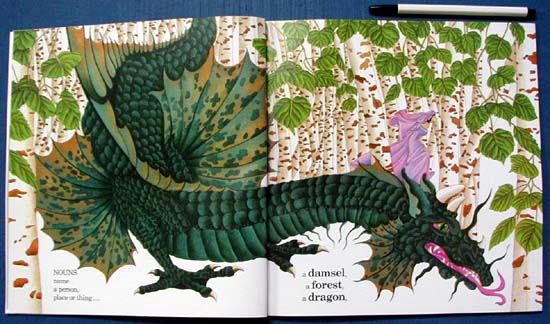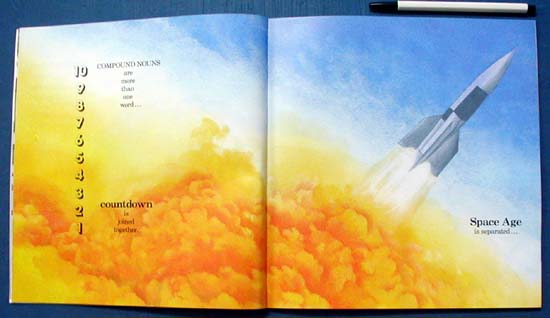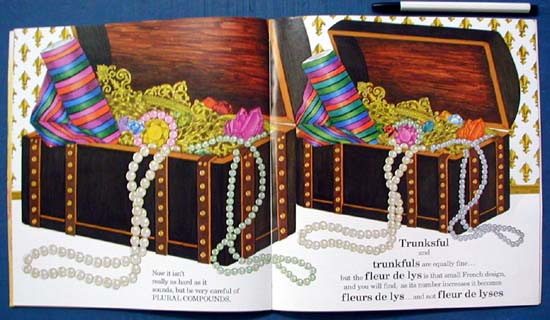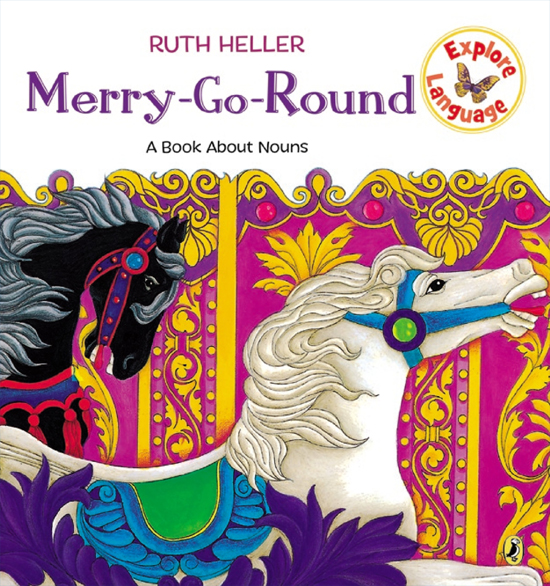|
|
|
|
 |
 이전 | 이전 |  목록 | 다음 목록 | 다음 |
|
|

상세그림 1 |

상세그림 2 |

상세그림 3 |

상세그림 4 |
|
확대 이미지 : 상세그림 1

|
확대 이미지 : 상세그림 2

|
확대 이미지 : 상세그림 3

|
확대 이미지 : 상세그림 4

|
[ 책 소개 ]
Ruth Heller 작품의 특징이라 할 수 있는 사실적이면서도 화려한 색상의 그림과 함께 영어 문법에 대해서 배울 수 있는 책입니다. 딱딱하고 어려운 문법을 쉽고 재미있게 익힐 수 있으며, 어린 아이들의 눈을 사로잡는 화려한 그림으로 인해 이 책을 통해 배운 문법은 어느 문법책보다도 오랫동안 기억에 남습니다.
보통명사, 고유명사, 추상명사, 구상명사, 복합명사, 집합명사, 단수명사, 복수명사, 소유격명사, 한정사 등 모든 종류의 명사의 용법과 예문을 배울 수 있습니다. 명사들이 어떤 모습으로 활용되는지 제시되는 그림과 연관된 예문을 봄으로써 더욱 쉽게 이해할 수 있습니다.
[ 서지 정보]
Edition: Paperback: 48 pages
ISBN-10: 0698116429
ISBN-13: 978-0698116429
책 크기 : 23.3cm x 22.2cm
[ 영문 서평 ]
Book Description
With humor, style, and succinct, admirable precision, Heller summarizes everything most people will ever need to know about this particular area of grammarA treasure. --Kirkus Reviews Its lush, exuberant, full-color artwork will grab kids' attention, even if they're sitting at the back of the classroom. --Booklist Her subject, made interesting by a rhyming text and brilliantly colored picture, will appeal to everyone. -- Horn Book Q&A - Ruth Heller - A Paperstar Profile How did you become interested in writing books for children? I loved reading to my own children, and when they started school, I became the P.T.A. library chairman. I was the one who got to pick and choose and spend a nice fat budget for the elementary school library. I feel as though I've been surrounded by children's books for years. I suppose this and my strong art background are what prompted my trying to write. What is the biggest influence in your style of writing, and how has it changed since you first began? Hillaire Belloc, Gilbert and Sullivan, Edward Lear--I grew up reading all of them. I love their rhythm, and I loved reading Dr. Seuss to my children. No question, these were my influences. I think I've become wordier, not quite as minimal and succinct as I used to be. What made you decide to write a series on the parts of speech? Take a peek at the back end paper of the hardcover edition of A Cache of Jewels. You'll see that I committed myself, in print, to writing a book for each part of speech. Here I am, ten years later, thankfully completing the very last book in this series. It will be published in 1998. Do you begin with the words or pictures when you are developing a book? How does the second part come together? The first step is to decide what I am going to say on each page. Then I can begin to visualize my illustrations. The words dictate what the illustration will be, but that still gives me many options. Sometimes the two come together easily, sometimes not. If not, I pursue new research material until something clicks. Did you learn anything new about the parts of speech while writing these books? I learned many things I had forgotten, and some new information and rules that I had never known. I also learned that the textbooks that I used for research were difficult to understand and somewhat boring, and that I am guilty of frequent misuse of the English language. How do you choose the images in your book? An art teacher once told me to fall in love with whatever I was drawing. So I choose images that I love: candy, ice cream, butterflies, sea creatures, carousels, jewels, etc. --This text refers to the Paperback edition.
Q&A - Ruth Heller - A Paperstar Profile
How did you become interested in writing books for children? I loved reading to my own children, and when they started school, I became the P.T.A. library chairman. I was the one who got to pick and choose and spend a nice fat budget for the elementary school library. I feel as though I?e been surrounded by children? books for years. I suppose this and my strong art background are what prompted my trying to write. What is the biggest influence in your style of writing, and how has it changed since you first began? Hillaire Belloc, Gilbert and Sullivan, Edward Lear? grew up reading all of them. I love their rhythm, and I loved reading Dr. Seuss to my children. No question, these were my influences. I think I?e become wordier, not quite as minimal and succinct as I used to be. What made you decide to write a series on the parts of speech? Take a peek at the back end paper of the hardcover edition of A Cache of Jewels. You?l see that I committed myself, in print, to writing a book for each part of speech. Here I am, ten years later, thankfully completing the very last book in this series. It will be published in 1998. Do you begin with the words or pictures when you are developing a book? How does the second part come together? The first step is to decide what I am going to say on each page. Then I can begin to visualize my illustrations. The words dictate what the illustration will be, but that still gives me many options. Sometimes the two come together easily, sometimes not. If not, I pursue new research material until something clicks. Did you learn anything new about the parts of speech while writing these books? I learned many things I had forgotten, and some new information and rules that I had never known. I also learned that the textbooks that I used for research were difficult to understand and somewhat boring, and that I am guilty of frequent misuse of the English language. How do you choose the images in your book? An art teacher once told me to fall in love with whatever I was drawing. So I choose images that I love: candy, ice cream, butterflies, sea creatures, carousels, jewels, etc.
Publisher's Weekly
To say that Heller has a way with words is to understate a multifaceted talent. In her previous books on language, her spirited verse and vibrantly hued pictures have provided lively lessons on the meaning of collective nouns, verbs and adjectives. Here, she examines nouns of all kinds: common and proper, abstract and concrete, compound, collective, singular and plural. The rhymed text of this book is as witty and smooth as its predecessors. Heller's vivid illustrations include a scaly, purple-tongued dragon; armored knights on horseback; a quartet of carousel animals; and a spectrum of fish, fruits and flowers. Intricate background patterns and designs further enrich many of the pages. Rarely does a book offer children so much to look at, listen to and learn.
Children's Literature
One of four books in the "World of Language" series, Heller informs and entertains as she teaches kids about the various parts of speech. This entry is about nouns-those words that name a person, place or thing. The illustrations are pure delight as readers meet abstract nouns, concrete nouns, compound nouns, and learn about plurals including those tricky words that end in "fe" and nouns that remain the same or become entirely new words. It's a great ways to help allay fears and to remove potential boredom from a grammar lesson. A good choice for any library and home too. Bold, bright illustrations and playful rhymes introduce the particulars and peculiarities of the parts of speech in 10 inch-square books easy to hold up in front of a group as you sensitize youngsters to what makes good English. Ms Heller's similar Many Luscious Lollipops, Kites Sail High, and A Cache of Jewels target adjectives, verbs, and collective nouns, respectively.
School Library Journal
Nouns of all kinds are the subject of Heller's latest in her series of books on parts of speech. Common, proper, abstract, concrete, compound, and collective nouns are all defined and shown by example in usually lilting verse. Singular, plural, and possessive forms of nouns are also thoroughly covered, and determiners are explained and demonstrated. The rhyme form is used with amazing skill but now and then seems forced as in, ``Nouns are highly effective./ The last kind of NOUN is . . . COLLECTIVE.'' How and why they work are not explained. Striking graphic design with large clear objects in bold colors overflowing each double-page spread make the book a visual treat. The use of bold type for all the nouns is particularly pleasing and will make for easy reading aloud. Heller's language books challenge users' creativity since the concepts are difficult for the picture-book format. Conversely, the verse and illustrations can delight very young children while older readers are sure to find the concise definitions clearer and certainly more entertaining than any grammar text. Those who have found the others in the series successful will want this one.
|
| * 작가의 다른 작품(2) |
The Korean Cinderella - 하드커버 특가판매, 슈퍼바이
The Korean Cinderella
하드커버 특가판매, 슈퍼바이 | Cats - Ruth Heller's Designs for Coloring, 슈퍼바이
Cats
Ruth Heller's Designs for Coloring, 슈퍼바이 |
| * 최근 이 작품을 구입하신 분들의 다른 선택 |
The Boy Who Harnessed the Wind
Amazon Best Books of the Year, 하드커버, 슈퍼바이 |
A Three Hat Day
ALA Notable Children's Books, 페이퍼백, 슈퍼바이 |
Show-How Guides: Friendship Bracelets
하드커버, 슈퍼바이 |
Biscuit's Pet & Play Halloween: A Touch & Feel Book
촉감책, 보드북, 슈퍼바이 |
|
| |
|
|< << [1] [2] [3] [4] [5] [6] [7] [8] [9] [10] >> >|
|
|
|